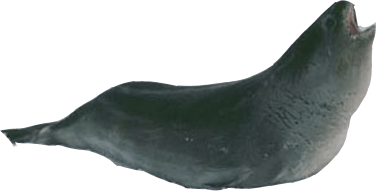Ross Seal

Scientific Classification
- Kingdom: Animalia
- Phylum: Chordata
- Class: Mammalia
- Order: Carnivora
- Suborder: Pinnipedia
- Family: Phocidae
Description
Ross seals look dissimilar than other seals. They have a smaller, wider head, and a small snout. They also have a small mouth and the straight hair of any seal. In its place of being dotted like many other seal species, Ross seals have a marked pattern on the sides of the neck and down the throat. Sometimes the streaked pattern looks like a mask.
Size
Ross Seals have a body length between 1.7 and 3 m (5.5 - 9.75 ft) and they weights ranging from 130 and 215 kgs (290 - 470 lbs).
Diet
Ross Seals generally feed on fish, squid and krill and they dive to depths of several hundred metres to grasp their prey.
Habitat
Mostly found deep within deep pack ice. Also found on island coasts in the winter (through the Astral summer).
Breeding
After a growth period of 9 months, Ross Seals provide birth to a single pup. They are weaned at 4 - 6 weeks old and they appear at sexual maturity at 2 - 4 years of age.
Interesting Facts
Ross Seals are named behind Sir James Clark Ross who led the Erebus and Terror expeditions to the Antarctic.
Ross Seals are also known as: Bigeyed Seal
 Deep Sea Crabs
Deep Sea Crabs